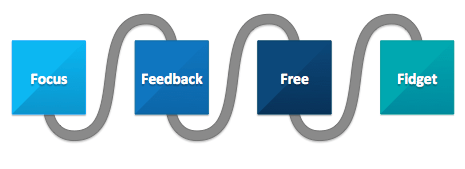News & Stories
The yin and yang of communication
 A professor walks into the classroom at 9:28 in the morning to teach a 9:30 class. She opens up a PowerPoint, greets the class and begins to teach about persuasive communication strategies. She speaks loudly and enthusiastically, pointing at the board and calling on students to answer questions.
A professor walks into the classroom at 9:28 in the morning to teach a 9:30 class. She opens up a PowerPoint, greets the class and begins to teach about persuasive communication strategies. She speaks loudly and enthusiastically, pointing at the board and calling on students to answer questions.
After finishing her presentation, the professor looks around the room, immediately noticing some vast differences among her students. While some students are sitting upright, engaged and taking notes, others are slouched back in their chairs or even looking at their laptops or down at their phones.
 At some point in our lives, many of us have experienced a situation similar to this first hand. Now, take this example and apply it to a business or conference setting. Can you imagine how the presenter would feel about the business after this type of audience behavior? Can you imagine how a boss would feel if his workers were ignoring a guest or another co-worker?
At some point in our lives, many of us have experienced a situation similar to this first hand. Now, take this example and apply it to a business or conference setting. Can you imagine how the presenter would feel about the business after this type of audience behavior? Can you imagine how a boss would feel if his workers were ignoring a guest or another co-worker?
 Many people forget that communication is two-sided. It is a reciprocal relationship that’s not just about talking, but also about listening – the area we often ignore. If asked earlier, many would have defined the communication in this example simply as the professor’s verbal and nonverbal communication – but this is not the only communication occurring. The students listening to the presentation are also communicating. If you are checking your phone or email during a presentation, it insinuates that you are uninterested, don’t care and have more important things to do. This behavior is considered rude in any setting – especially a professional setting, where it can potentially damage future relationships.
Many people forget that communication is two-sided. It is a reciprocal relationship that’s not just about talking, but also about listening – the area we often ignore. If asked earlier, many would have defined the communication in this example simply as the professor’s verbal and nonverbal communication – but this is not the only communication occurring. The students listening to the presentation are also communicating. If you are checking your phone or email during a presentation, it insinuates that you are uninterested, don’t care and have more important things to do. This behavior is considered rude in any setting – especially a professional setting, where it can potentially damage future relationships.
 Listening to a presentation may sometimes elicit a more passive communication style. However, this does not mean that this communication goes unnoticed. Listening is a form of communication that can set a positive or negative precedent for the rest of the interaction. Many people forget that nonverbal communication can generate emotions, reactions and interpretations the same way that verbal communication can. Even as a listener, you can play an active role in communication.
Listening to a presentation may sometimes elicit a more passive communication style. However, this does not mean that this communication goes unnoticed. Listening is a form of communication that can set a positive or negative precedent for the rest of the interaction. Many people forget that nonverbal communication can generate emotions, reactions and interpretations the same way that verbal communication can. Even as a listener, you can play an active role in communication.
 Since we often forget the listening portion of a reciprocal communicative relationship, I created the“Four Fs” to remind business people how to be more engaged listeners and active participants during meetings, conferences and presentations.
Since we often forget the listening portion of a reciprocal communicative relationship, I created the“Four Fs” to remind business people how to be more engaged listeners and active participants during meetings, conferences and presentations.
Focus
Give the speaker your undivided attention. Focus on what the person has to say and then respond accordingly. In such a technology-centered world, attention spans have started to dwindle, making it even more difficult to focus. In fact, according to Microsoft Corp., people now generally lose concentration after eight seconds, which is less than the nine-second attention span of a goldfish. My advice: beat the goldfish and pay attention.
Feedback
Answer questions, ask good questions and maybe even verbally agree with points throughout the presentation. You can also use body language – like head nodding – to signal agreement or understanding.
Free
Free yourself from judgment. Some people may act uninterested or rude simply because they disagree with the speaker. You do not have to agree with others’ opinions or beliefs in order to communicate effectively. If you share differing opinions, take this opportunity to ask questions and learn more about why they feel this specific way. If you leave judgment behind, your conversation can become more comfortable and informative.
Fidget
Be aware of your body language. When you are listening to someone speak, stop fidgeting, stop fiddling and look up. Don’t be playing on your phone or sending emails on your computer. Reciprocate eye contact, nod your head if you agree and smile. Your body language can create an open or defensive communication atmosphere.
The yin cannot exist without the yang. Lord Voldemort couldn’t exist without Harry Potter. Effective communication cannot exist without active listening. Use the “Four Fs” to better your business communication and remember that effective communication requires both speaking and listening.
By Mary Tuggle (BSBA ’17)
